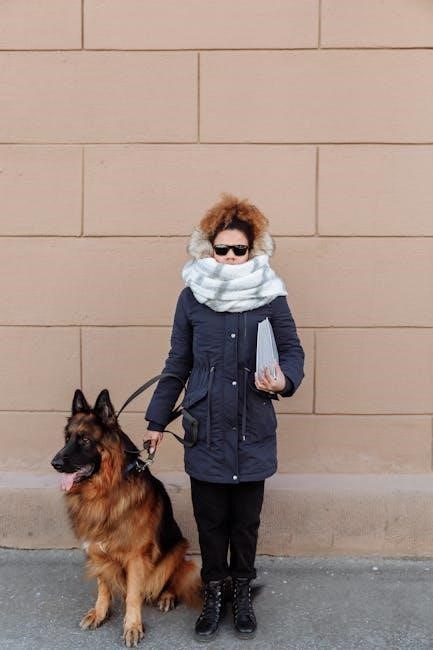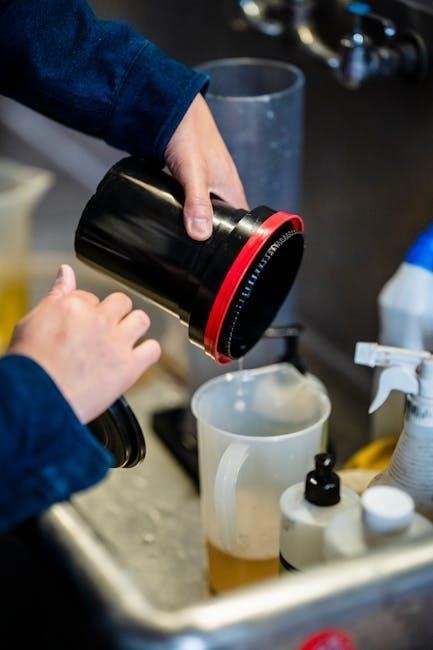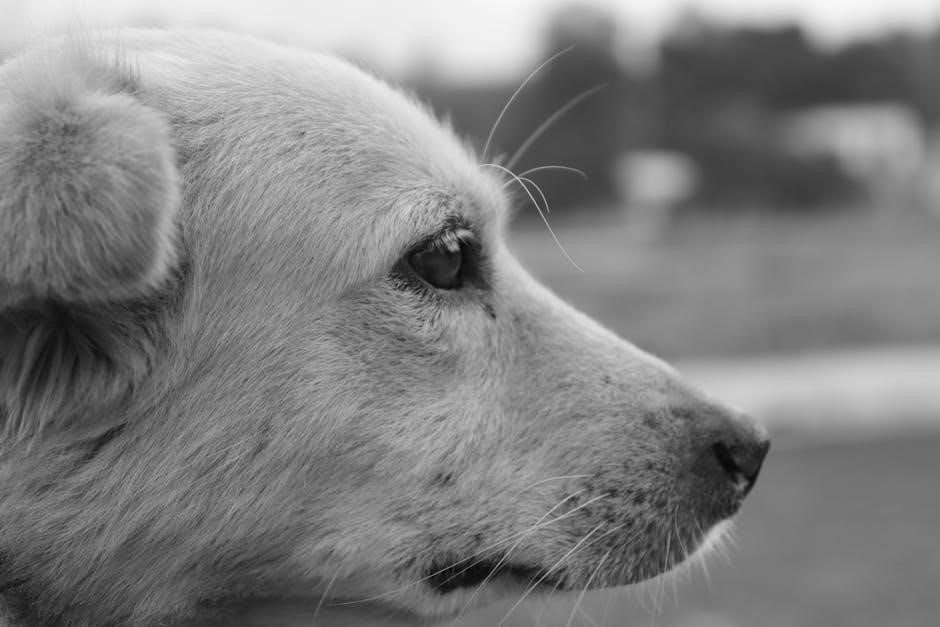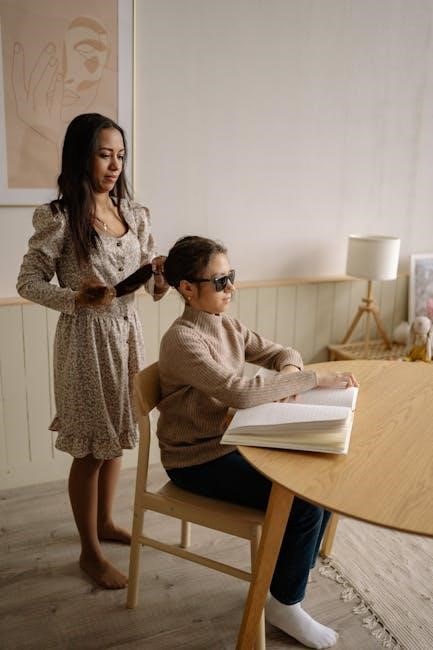Guiding Eyes for the Blind is a nonprofit organization dedicated to empowering individuals with visual impairments through expertly trained guide dogs․ Located in Patterson, NY, the Canine Development Center specializes in breeding, socializing, and training guide dogs, utilizing state-of-the-art facilities and green construction to ensure optimal care and development․ The center plays a pivotal role in the organization’s mission to foster independence and mobility, offering life-changing partnerships between dogs and handlers․

1․1 Overview of the Organization
Guiding Eyes for the Blind is a nonprofit organization headquartered in Patterson, NY, dedicated to enhancing the lives of individuals with visual impairments․ The Canine Development Center (CDC) serves as the cornerstone of their operations, focusing on breeding, socializing, and training guide dogs․ The CDC is part of a broader network that includes a training school and veterinary services, ensuring a comprehensive approach to guide dog development․ By combining state-of-the-art facilities with green construction practices, Guiding Eyes creates an optimal environment for raising and training dogs․ Their mission emphasizes fostering independence and mobility, making them a leader in the field of guide dog services․
1․2 Mission and Vision
Guiding Eyes for the Blind is driven by a mission to empower individuals with visual impairments by providing expertly trained guide dogs․ Their vision is to foster independence, mobility, and confidence through life-changing partnerships․ The organization is committed to innovation, ensuring the highest quality in breeding, training, and matching dogs with handlers․ By prioritizing individual needs and leveraging advanced training techniques, Guiding Eyes strives to set the standard for guide dog services․ Their vision extends to building a supportive community and expanding access to their programs, ensuring that everyone who needs a guide dog can benefit from their transformative work․
History and Evolution of the Canine Development Center
The Canine Development Center was established to advance guide dog training and breeding․ Over the years, it has expanded, incorporating state-of-the-art facilities and innovative training methods․
2․1 Founding and Early Years
Guiding Eyes for the Blind’s Canine Development Center was established to advance the breeding and training of guide dogs․ Nestled in Patterson, NY, the center began as a modest facility dedicated to producing high-potential puppies․ Its early years focused on creating a nurturing environment for puppy socialization and foundational training․ The center’s inception marked a significant step in the organization’s mission to provide guide dogs to individuals with visual impairments․ By focusing on careful breeding and early development, the Canine Development Center laid the groundwork for the organization’s success in fostering independence and mobility through life-changing partnerships․
2․2 Key Milestones in Development
The Canine Development Center has achieved significant milestones, expanding its capabilities to enhance guide dog production․ A major milestone was the establishment of its 30-acre campus in Patterson, NY, featuring state-of-the-art facilities․ The introduction of green construction initiatives underscored its commitment to sustainability․ Key developments include the addition of new kennels, training pavilions, and a veterinary hospital, ensuring optimal care for dogs․ These advancements have enabled the center to improve breeding, socialization, and training processes, leading to higher success rates in producing guide dogs․ These milestones reflect the organization’s dedication to innovation and excellence in supporting individuals with visual impairments․
Facilities and Infrastructure
Guiding Eyes’ Canine Development Center features a 30-acre campus with state-of-the-art kennels, training pavilions, and a veterinary hospital, all designed to support guide dog development and care․
3․1 Location and Campus Overview
The Canine Development Center is located at 361 Route 164 in Patterson, NY, nestled in a scenic hillside․ The 30-acre campus is modest in appearance but houses essential facilities for guide dog development․ It includes kennels, training pavilions, and a veterinary hospital, along with outdoor exercise areas and open living spaces․ The center is a crucial part of Guiding Eyes’ operations, focusing on breeding, socialization, and initial training of future guide dogs․ Its strategic location supports the organization’s mission to provide life-changing companionship and mobility to individuals with visual impairments․
3․2 State-of-the-Art Features and Green Construction
The Canine Development Center boasts state-of-the-art facilities designed with sustainability in mind․ Constructed using green building initiatives, the campus incorporates eco-friendly materials and energy-efficient systems to minimize its environmental footprint․ The center features advanced ventilation systems, natural lighting, and open spaces that promote a healthy environment for both dogs and staff․ These modern amenities ensure optimal conditions for breeding, training, and caring for guide dogs, aligning with Guiding Eyes’ commitment to excellence and innovation in service to individuals with visual impairments․
3․3 Kennels, Training Pavilions, and Veterinary Hospital
The Canine Development Center is equipped with modern kennels designed for comfort and safety, providing ample space for dogs to rest and thrive․ Training pavilions are tailored for various stages of guide dog education, ensuring a structured and effective learning environment․ Additionally, an on-site veterinary hospital offers comprehensive medical care, equipped with state-of-the-art equipment to address the health needs of the dogs․ These facilities collectively support the organization’s mission to breed, train, and care for guide dogs, ensuring they are well-prepared to assist individuals with visual impairments․ The seamless integration of these amenities underscores Guiding Eyes’ dedication to excellence in every aspect of their operations․

The Training Process
Guiding Eyes employs a comprehensive training approach, from early socialization to advanced techniques, ensuring dogs develop the skills needed to assist individuals with visual impairments effectively․
4․1 Early Socialization and Puppy Development
The Canine Development Center at Guiding Eyes for the Blind emphasizes early socialization as a cornerstone of puppy development․ From birth, puppies are exposed to diverse environments and experiences to foster confidence and adaptability․ The center’s nurturing setting, including kennels and training pavilions, provides a safe space for growth․ Volunteer puppy raisers play a crucial role, introducing pups to various social situations and teaching basic obedience․ This foundational phase ensures puppies develop the temperament and skills needed for advanced training, setting them on the path to becoming guide dogs․ The focus is on creating a strong, well-rounded foundation for their future roles․

4․2 Advanced Training Techniques

At the Canine Development Center, advanced training techniques refine the skills of young dogs, preparing them for their roles as guide dogs․ Trained in state-of-the-art pavilions, dogs learn to navigate complex environments, such as busy streets and public spaces․ Techniques include exposure to various obstacles, traffic scenarios, and commands that ensure safety and precision․ Positive reinforcement methods are employed to build confidence and reliability․ Dogs are also taught to respond to specific commands in noisy and distracting settings, ensuring they remain focused on their handlers․ These advanced techniques, combined with expert instruction, equip the dogs with the skills needed to assist individuals with visual impairments effectively․
4․3 Matching Dogs with Handlers
The process of matching dogs with handlers is a critical step at the Canine Development Center․ Trained dogs are carefully evaluated for their temperament, skills, and compatibility with potential handlers․ Handlers, in turn, undergo assessments to determine their lifestyle, mobility needs, and preferences․ This meticulous matching ensures a harmonious partnership, maximizing the dog’s ability to assist effectively․ The center’s expert trainers use their knowledge of both the dogs and handlers to create ideal pairings․ Once matched, the duo undergoes final training together, solidifying their bond and preparing them for real-world challenges․ This personalized approach ensures that each team is well-suited to thrive in their new life together․

4․4 Public Access Training

Public access training is a cornerstone of the Canine Development Center’s program, ensuring guide dogs are prepared for real-world environments․ Dogs are trained to navigate stores, restaurants, public transportation, and crowded spaces, learning to remain calm and focused amidst distractions․ Trainers use positive reinforcement techniques to reinforce good behavior, teaching dogs to avoid obstacles and respond reliably to commands․ This phase emphasizes the dog’s ability to work seamlessly in public settings, ensuring they can confidently guide their handlers in any situation․ The center’s state-of-the-art facilities and experienced trainers play a crucial role in this advanced training, equipping dogs with the skills needed to thrive in diverse environments․

Breeding and Genetics Program
Guiding Eyes operates a robust breeding and genetics program, focusing on selecting and breeding dogs with ideal traits for guide work, ensuring healthy, capable candidates for training․
5․1 Selecting and Breeding Guide Dog Candidates
Guiding Eyes for the Blind employs a rigorous selection and breeding process to identify and produce high-potential guide dog candidates․ The program focuses on breeding dogs with exceptional intelligence, temperament, and physical traits, ensuring they are well-suited for guide work․ Genetic diversity and health are prioritized to minimize inherited issues․ Potential breeding dogs undergo comprehensive evaluations, including temperament assessments and health screenings, to determine their suitability․ The center’s breeding program is designed to produce puppies with the highest potential for success in guide dog training, laying the foundation for life-changing partnerships between dogs and individuals with visual impairments․
5․2 Genetic Screening and Health Testing
Guiding Eyes for the Blind prioritizes genetic screening and health testing to ensure the highest quality of life for their guide dogs․ Advanced genetic testing identifies potential health issues early, minimizing the risk of inherited diseases․ The organization screens for conditions such as hip dysplasia, eye disorders, and other genetic traits that could impact a dog’s ability to serve as a guide․ This rigorous process ensures that only the healthiest candidates progress through the program․ The state-of-the-art veterinary hospital at the Canine Development Center supports these efforts, providing comprehensive care and ensuring the well-being of all dogs․ These measures contribute to the success of guide dogs in their critical roles․
The Role of Volunteers and Puppy Raisers
Volunteers and puppy raisers are essential to Guiding Eyes for the Blind, providing care, socialization, and foundational training for puppies, preparing them for advanced guide dog training․
6․1 Puppy Raising Families and Their Contributions
Puppy raising families play a vital role in the early development of future guide dogs․ These families welcome puppies into their homes, providing love, care, and socialization․ They teach basic obedience, expose the puppies to various environments, and help them become confident in public settings․ The families’ dedication ensures the puppies are well-adjusted and prepared for advanced training․ Their contributions are instrumental in shaping the puppies’ behavior and laying the foundation for their future roles as guide dogs․ This selfless effort is a cornerstone of Guiding Eyes for the Blind’s success in producing highly skilled and compassionate guide dogs․
6․2 Volunteer Opportunities and Community Involvement
Guiding Eyes for the Blind offers numerous volunteer opportunities that foster community engagement and support its mission․ Individuals can contribute by raising puppies, assisting with events, or helping at the Canine Development Center․ Volunteers play a crucial role in socializing puppies, which is essential for their future as guide dogs․ Community involvement also includes fundraising efforts, spreading awareness, and participating in local events․ These contributions not only support the organization but also strengthen ties within the community․ By volunteering, individuals become part of a network dedicated to empowering those with visual impairments, creating a lasting impact on lives through their generosity and dedication․

Veterinary Services and Canine Care
Guiding Eyes operates a state-of-the-art veterinary hospital at its Canine Development Center, providing comprehensive health care for guide dogs․ Advanced equipment ensures optimal care and well-being․
7․1 On-Site Veterinary Hospital and Equipment
Guiding Eyes for the Blind features a state-of-the-art veterinary hospital at its Canine Development Center, equipped with advanced medical technology to ensure top-tier care for guide dogs․ The facility provides comprehensive health services, including preventive care, diagnostics, and surgical procedures, all tailored to the specific needs of guide dog candidates․ The hospital is staffed by skilled veterinarians and support teams dedicated to maintaining the health and well-being of the dogs․ This on-site resource enables prompt medical attention, reducing the need for external referrals and ensuring continuous monitoring of the dogs’ health from an early age․ The hospital plays a critical role in the overall success of the guide dog program․

Impact and Success Stories
Guiding Eyes for the Blind creates life-changing partnerships, empowering individuals with visual impairments to gain independence and mobility through expertly trained guide dogs, fostering confidence and emotional support․
8․1 Life-Changing Partnerships Between Dogs and Handlers
Guiding Eyes for the Blind fosters profound connections between guide dogs and their handlers, transforming lives through trust and companionship․ These specially trained dogs become an extension of their handlers, enabling individuals with visual impairments to navigate the world with confidence and independence․ The bond formed during training creates a partnership that goes beyond assistance, offering emotional support and a sense of freedom․ Handlers often share stories of how their guide dogs have empowered them to pursue daily activities, travel, and even build lasting friendships․ This unique relationship is at the heart of Guiding Eyes’ mission, creating a lasting impact on both individuals and their communities․
8․2 Measurable Outcomes and Success Rates
Guiding Eyes for the Blind consistently demonstrates high success rates in training and placing guide dogs․ Annually, the organization graduates over 200 dogs, with a 95% success rate in matching dogs with handlers․ The program’s rigorous training process ensures that dogs are well-prepared to assist individuals with visual impairments․ Handlers report a 98% satisfaction rate, highlighting the transformative impact of these partnerships․ The organization’s commitment to excellence is evident in its continuous improvement initiatives, ensuring that each dog meets the highest standards of reliability and skill․ These measurable outcomes underscore the program’s effectiveness in empowering individuals and fostering independence, making it a leader in the guide dog industry․
Future Plans and Expansion
Guiding Eyes plans to expand its facilities in Yorktown Heights, developing a new veterinary hospital and kennel․ Future projects include advanced training methods and sustainable building initiatives․
9․1 Upcoming Projects and Initiatives
Guiding Eyes for the Blind is advancing its mission with exciting new projects․ A state-of-the-art veterinary hospital and guide dog kennel are planned for Yorktown Heights, expanding care and training capacity․ The organization is also exploring innovative training methods and sustainable building practices to enhance its facilities․ These initiatives aim to improve efficiency, ensure the health of guide dogs, and strengthen the organization’s ability to serve individuals with visual impairments․ By investing in cutting-edge infrastructure and methodologies, Guiding Eyes continues to lead in the field of guide dog training and service․
